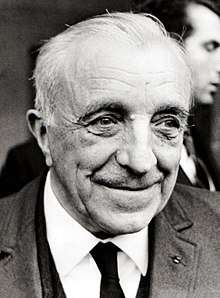Louis Néel
Louis Eugène Félix Néel ForMemRS (22 November 1904 – 17 November 2000) was a French physicist born in Lyon.[2]
Louis Néel | |
|---|---|
 Néel in 1970 | |
| Born | Louis Eugène Félix Néel 22 November 1904 |
| Died | 17 November 2000 (aged 95) |
| Alma mater | École Normale Supérieure, University of Paris[1] University of Strasbourg |
| Known for |
|
| Awards |
|
| Scientific career | |
| Fields | Solid-state physics |
| Institutions | CNRS, Grenoble |
| Doctoral advisor | Pierre Weiss |
Biography
Néel studied at the Lycée du Parc in Lyon and was accepted at the École Normale Supérieure in Paris. He obtained the degree of Doctor of Science at the University of Strasbourg. He was corecipient (with the Swedish astrophysicist Hannes Alfvén) of the Nobel Prize for Physics in 1970 for his pioneering studies of the magnetic properties of solids.[4] His contributions to solid state physics have found numerous useful applications, particularly in the development of improved computer memory units. About 1930 he suggested that a new form of magnetic behavior might exist; called antiferromagnetism, as opposed to ferromagnetism. Above a certain temperature (the Néel temperature) this behaviour stops. Néel pointed out (1948)[5] that materials could also exist showing ferrimagnetism. Néel has also given an explanation of the weak magnetism of certain rocks, making possible the study of the history of Earth's magnetic field.[6][7][8][9][10][11][12][13][14]
He is the instigator of the Polygone Scientifique in Grenoble.
The Louis Néel Medal, awarded annually by the European Geophysical Society, is named in Néel's honour.
Awards and honours
Néel received numerous awards and honours for his work including:
Awards
- Hughes Prize of the Académie des sciences (1935)
- Félix Robin Prize of the Société française de physique (1938)
- André Blondel Medal (1948)
- Grand prix du conseil de l’association « Au service de la pensée française » (1949)
- Holweck Prize (1952)[15]
- Elected Foreign Member of the Royal Netherlands Academy of Arts and Sciences (1959)[16]
- Three Physicists Prize (1963)
- Gold Medal of CNRS (1965)
- Elected Foreign Member of the Royal Society (ForMemRS) in 1966[2]
- Nobel Prize in Physics (1970)
- Great Gold Medal of l’Électronique (1971)
- Great Gold Medal of the Société d’encouragement pour la recherche et l’invention (1973)
- Founding member of the World Cultural Council (1981).[17]
Distinctions
Owing to his involvement in national defense, particularly through research in the protection of warships by demagnetization against magnetic mines, he received numerous distinctions:
- Legion of Honour:
- Knight (for exceptional military services) (1940)
- Officer (1951)
- Commander (1958)
- Grand Officer (1966)
- Grand Cross (1974)
- Croix de Guerre with Palm (1940)
- Commander of the Ordre des Palmes Académiques (1957)
- Knight of the Order of Social Merit (1963)
- Grand Cross of the National Order of Merit (1972)
- Honorary Admiral (French Navy)
References
| Wikiquote has quotations related to: Louis Néel |
- At the time, the ENS was part of the University of Paris according to the decree of 10 November 1903.
- Friedel, J.; Averbuch, P. (1 December 2003). "Louis Eugène Félix Néel. 22 November 1904 – 17 November 2000". Biographical Memoirs of Fellows of the Royal Society. 49: 367–384. doi:10.1098/rsbm.2003.0021.
- "The Nobel Prize in Physics 1970". The Nobel Foundation. Retrieved 20 June 2012.
- Néel, L. (3 December 1971). "Magnetism and Local Molecular Field". Science. 174 (4013): 985–992. Bibcode:1971Sci...174..985N. doi:10.1126/science.174.4013.985. PMID 17757022.
- Néel, Louis (1948). "Magnetic Properties of Ferrites: Ferrimagnetism and Antiferromagnetism". Ann. Phys. (Paris). 3: 137–198.
- Néel, Louis (1 April 1955). "Some theoretical aspects of rock-magnetism". Advances in Physics. 4 (14): 191–243. Bibcode:1955AdPhy...4..191N. doi:10.1080/00018735500101204.
- Barbara, B.; Lacroix, Claudine (2000). "Retrospective in Science: Louis Neel (1904–2000)". Science. 291 (5506): 1000. doi:10.1126/science.1059052. PMID 11232560.
- Coey, Michael (2001). "Obituary: Louis Néel (1904–2000)". Nature. 409 (6818): 302. Bibcode:2001Natur.409..302C. doi:10.1038/35053274.
- Coey, J. M. D. (2003). "Louis Néel: Retrospective (invited)". Journal of Applied Physics. 93 (10): 8224–8229. Bibcode:2003JAP....93.8224C. doi:10.1063/1.1557815.
- Dunlop, David J. (2003). "Partial thermoremanent magnetization: Louis Néel's legacy in rock magnetism (invited)". Journal of Applied Physics. 93 (10): 8236–8240. Bibcode:2003JAP....93.8236D. doi:10.1063/1.1558640.
- "Louis Néel – Biography". Nobel Lectures, Physics 1963–1970. Elsevier Publishing Company.
- Néel, Louis (1991). Un siècle de physique. Paris: Jacob. ISBN 978-2-7381-0140-2.
- "Louis Néel, un siècle de science à Grenoble". 2004. Archived from the original on 4 June 2011. Retrieved 27 October 2011.
- Kurti, Nicholas, ed. (1988). Selected works of Louis Néel. New York: Gordon and Breach. ISBN 978-2-88124-300-4.
- "Holweck medal recipients". Institute of Physics. Retrieved 14 January 2020.
- "Louis Eugène Felix Néel (1904 - 2000)". Royal Netherlands Academy of Arts and Sciences. Archived from the original on 5 July 2020.
- "About Us". World Cultural Council. Retrieved 8 November 2016.
External links
| Wikimedia Commons has media related to Louis Néel. |
- Louis Néel on Nobelprize.org including the Nobel Lecture, December 11, 1970 Magnetism and the Local Molecular Field
